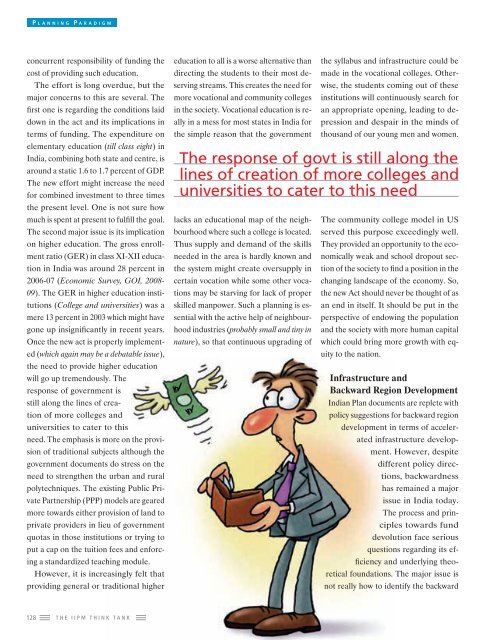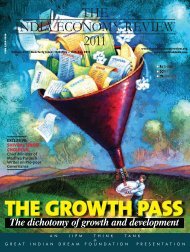Download - The India Economy Review
Download - The India Economy Review
Download - The India Economy Review
Create successful ePaper yourself
Turn your PDF publications into a flip-book with our unique Google optimized e-Paper software.
P LANNING P ARADIGM<br />
concurrent responsibility of funding the<br />
cost of providing such education.<br />
<strong>The</strong> effort is long overdue, but the<br />
major concerns to this are several. <strong>The</strong><br />
fi rst one is regarding the conditions laid<br />
down in the act and its implications in<br />
terms of funding. <strong>The</strong> expenditure on<br />
elementary education (till class eight) in<br />
<strong>India</strong>, combining both state and centre, is<br />
around a static 1.6 to 1.7 percent of GDP.<br />
<strong>The</strong> new effort might increase the need<br />
for combined investment to three times<br />
the present level. One is not sure how<br />
much is spent at present to fulfi ll the goal.<br />
<strong>The</strong> second major issue is its implication<br />
on higher education. <strong>The</strong> gross enroll-<br />
ment ratio (GER) in class XI-XII educa-<br />
tion in <strong>India</strong> was around 28 percent in<br />
2006-07 (Economic Survey, GOI, 2008-<br />
09). <strong>The</strong> GER in higher education insti-<br />
tutions (College and universities) was a<br />
mere 13 percent in 2003 which might have<br />
gone up insignifi cantly in recent years.<br />
Once the new act is properly implement-<br />
ed (which again may be a debatable issue),<br />
the need to provide higher education<br />
will go up tremendously. <strong>The</strong><br />
response of government is<br />
still along the lines of crea-<br />
tion of more colleges and<br />
universities to cater to this<br />
need. <strong>The</strong> emphasis is more on the provi-<br />
sion of traditional subjects although the<br />
government documents do stress on the<br />
need to strengthen the urban and rural<br />
polytechniques. <strong>The</strong> existing Public Private<br />
Partnership (PPP) models are geared<br />
more towards either provision of land to<br />
private providers in lieu of government<br />
quotas in those institutions or trying to<br />
put a cap on the tuition fees and enforcing<br />
a standardized teaching module.<br />
However, it is increasingly felt that<br />
providing general or traditional higher<br />
128 THE IIPM THINK TANK<br />
education to all is a worse alternative than<br />
directing the students to their most deserving<br />
streams. This creates the need for<br />
more vocational and community colleges<br />
in the society. Vocational education is really<br />
in a mess for most states in <strong>India</strong> for<br />
the simple reason that the government<br />
lacks an educational map of the neighbourhood<br />
where such a college is located.<br />
Thus supply and demand of the skills<br />
needed in the area is hardly known and<br />
the system might create oversupply in<br />
certain vocation while some other vocations<br />
may be starving for lack of proper<br />
skilled manpower. Such a planning is essential<br />
with the active help of neighbourhood<br />
industries (probably small and tiny in<br />
nature), so that continuous upgrading of<br />
the syllabus and infrastructure could be<br />
made in the vocational colleges. Otherwise,<br />
the students coming out of these<br />
institutions will continuously search for<br />
an appropriate opening, leading to depression<br />
and despair in the minds of<br />
thousand of our young men and women.<br />
<strong>The</strong> response of govt is still along the<br />
lines of creation of more colleges and<br />
universities to cater to this need<br />
<strong>The</strong> community college model in US<br />
served this purpose exceedingly well.<br />
<strong>The</strong>y provided an opportunity to the economically<br />
weak and school dropout section<br />
of the society to fi nd a position in the<br />
changing landscape of the economy. So,<br />
the new Act should never be thought of as<br />
an end in itself. It should be put in the<br />
perspective of endowing the population<br />
and the society with more human capital<br />
which could bring more growth with equity<br />
to the nation.<br />
Infrastructure and<br />
Backward Region Development<br />
<strong>India</strong>n Plan documents are replete with<br />
policy suggestions for backward region<br />
development in terms of accelerated<br />
infrastructure development.<br />
However, despite<br />
different policy directions,<br />
backwardness<br />
has remained a major<br />
issue in <strong>India</strong> today.<br />
<strong>The</strong> process and principles<br />
towards fund<br />
devolution face serious<br />
questions regarding its effi<br />
ciency and underlying theoretical<br />
foundations. <strong>The</strong> major issue is<br />
not really how to identify the backward





